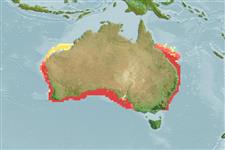Lớp phụ Cá sụn (cá mập và cá đuối) (sharks and rays) >
Torpediniformes (Electric rays) >
Hypnidae (Coffin rays)
Etymology: Hypnos: Greek, hypnos = sleep (Ref. 45335).
More on author: Shaw.
Environment: milieu / climate zone / depth range / distribution range
Sinh thái học
Biển Cùng sống ở rạn san hô; Mức độ sâu 0 - 240 m (Ref. 9710). Temperate; 18°S - 38°S, 112°E - 155°E (Ref. 114953)
Indo-West Pacific: endemic to Australia.
Length at first maturity / Bộ gần gũi / Khối lượng (Trọng lượng) / Age
Maturity: Lm ?, range 24 - ? cm
Max length : 70.0 cm TL con đực/không giới tính; (Ref. 2272); common length : 40.0 cm TL con đực/không giới tính; (Ref. 6871)
Occurs inshore and offshore, ranging from the intertidal to 240 m depth (Ref. 9910, 12951). Found buried on sand and mud bottoms; sometimes found stranded out of water by the tide but is capable of surviving for hours (Ref. 9910). Feeds on crabs, worms, and fishes. It was reported that larger fishes, similar size to themselves have been found in the stomachs of Coffin rays, ingested whole through the large gape (Ref. 114953). Ovoviviparous (Ref. 50449). Maximum length probably to 92 cm TL (Ref. 9910). Both sexes mature at 40-48 cm TL; born at ca. 8-11 cm TL (Ref. 114953). A slow-moving species which uses its electric organs to stun prey. Also stuns people when accidentally stepped upon or handled (Ref. 9910).
Life cycle and mating behavior
Chín muồi sinh dục | Sự tái sinh sản | Đẻ trứng | Các trứng | Sự sinh sản | Ấu trùng
Exhibit ovoviparity (aplacental viviparity), with embryos feeding initially on yolk, then receiving additional nourishment from the mother by indirect absorption of uterine fluid enriched with mucus, fat or protein through specialised structures (Ref. 50449). Size at birth 8 to 11 cm TL (Ref. 9910).
Compagno, L.J.V., 1999. Checklist of living elasmobranchs. p. 471-498. In W.C. Hamlett (ed.) Sharks, skates, and rays: the biology of elasmobranch fishes. Johns Hopkins University Press, Maryland. (Ref. 35766)
IUCN Red List Status (Ref. 130435)
Human uses
Các nghề cá: không ích lợi (thú vị)
Thêm thông tin
Age/SizeSự sinh trưởngLength-weightLength-lengthLength-frequenciesSinh trắc họcHình thái họcẤu trùngSự biến động ấu trùngBổ xungSự phong phúBRUVS
Các tài liệu tham khảoNuôi trồng thủy sảnTổng quan nuôi trồng thủy sảnCác giốngDi truyềnElectrophoresesDi sảnCác bệnhChế biếnNutrientsMass conversion
Các công cụ
Special reports
Download XML
Các nguồn internet
Estimates based on models
Preferred temperature (Ref.
123201): 15.3 - 22.2, mean 17.4 °C (based on 134 cells).
Phylogenetic diversity index (Ref.
82804): PD
50 = 1.5000 [Uniqueness, from 0.5 = low to 2.0 = high].
Bayesian length-weight: a=0.01000 (0.00244 - 0.04107), b=3.04 (2.81 - 3.27), in cm total length, based on all LWR estimates for this body shape (Ref.
93245).
Mức dinh dưỡng (Ref.
69278): 3.7 ±0.57 se; based on food items.
Fishing Vulnerability (Ref.
59153): Moderate to high vulnerability (48 of 100).
Nutrients (Ref.
124155): Calcium = 2.47 [0.28, 38.57] mg/100g; Iron = 0.157 [0.013, 1.622] mg/100g; Protein = 17.1 [13.0, 20.7] %; Omega3 = 0.302 [0.099, 0.903] g/100g; Selenium = 9.87 [1.75, 49.78] μg/100g; VitaminA = 21.6 [1.7, 276.9] μg/100g; Zinc = 0.479 [0.035, 5.305] mg/100g (wet weight);
